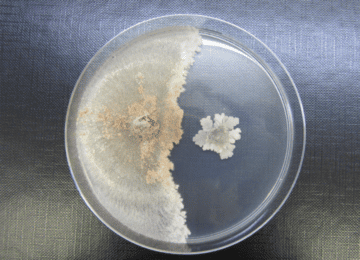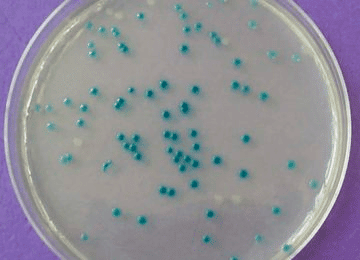

Bacillus Subtilis
Bacillus subtilis, referred to in abbreviation as B. subtilis, is also known by two nicknames: hay bacillus and grass bacillus.
Bacillus Subtilis Protein Expression Overview
In the biotechnology research world, B. subtilis is often selected as a protein expression host due to its capacity to secrete active enzymes at high levels, similar to E. coli. But unlike E. coli, B. subtilis is nonpathogenic and nontoxigenic.
What Is Bacillus Subtilis?
B. subtilis is a gram-positive, catalase-positive type of bacteria with a variety of applications in the medical sciences.
Where Is Bacillus Subtilis Found?
B. subtilis is found naturally in upper layers of soil and vegetation, as well as the gastrointestinal tract of some animals – including ruminating mammals, humans, honey bees, and marine sponges.
Habitat Overview
Through hydrolysis, B. subtilis is able to form a tough, protective endospore that allows it to tolerate extreme environmental conditions – such as the gut flora of living animals – while avoiding desiccation.
A single B. subtilis endospore can remain viable for decades, even under stresses like drought, salinity, extreme pH levels, and radiation, until environmental conditions once again become favorable.
Bacillus Subtilis Morphology and Physiology
Multiple inducible or constitutive promoters and various secretion signal peptides are available to optimize protein expression in B. subtilis.
Shape
B. subtilis is rounded, slender, and rod-shaped.
Size
A B. subtilis bacterium is typically 4–10 micrometers long, and 0.25–1.0 μm in diameter. Its volume is about 4.6 fL at stationary phase.
Color
B. subtilis bacteria is typically whitish in color.
Morphology
B. subtilis is heavily flagellated, which gives it the ability to move quickly in liquids.
A Brief History of Bacillus
B. subtilis has long been one of the most widely used protein expression hosts for enzymes in food applications. The products made in B. subtilis, such as carbohydrase and protease, have GRAS (Generally Recognized as Safe) status from the FDA.
Who Discovered Bacillus Subtilis?
German scientist Christian Gottfried Ehrenberg discovered B. subtilis in 1835, originally naming it “Vibrio subtilis.” It was renamed in 1872 by German biologist Ferdinand Cohn under current taxonomy.
Before antibiotics entered the picture, clinicians across the world used B. subtilis through the 1950s as an immunostimulatory agent to treat gastrointestinal and urinary tract diseases.
Bacitracin is an antibiotic typically used topically for skin and eye infections. It is a mixture of related cyclic peptides produced by Bacillus licheniformis, a bacterium of the same genus as B. subtilis.
How Is Bacillus Subtilis Used Today?
Due to its endospores’ ability to survive up to 6 years in space, NASA has been using B. subtilis since the 1960s as a test species when conducting spaceflight experimentation.
In academic settings, B. subtilis is considered a model organism for the study of bacterial chromosome replication and cell differentiation, in part because of its responsiveness to genetic manipulation.
In biotechnology spaces like ours, B. subtilis is a very attractive host for enzyme production.
Current Trends
In recent years, scientists have continued to find novel ways to use B. subtilis in various settings.
It currently plays a role in:
- Disposing safely of radionuclide waste
- Speeding growth of saffron
- Inoculating soil against pests and fungi without interfering with pollination
- Gold cycling in geological systems
The Future of B. Subtilis Research and Usage
Because B. subtilis cells have been shown to reduce gold via biotic reduction when oxygen is present, it’s being explored as an agent in recovering solid gold from geological systems.
Its applications in the agricultural industry continue to expand as well.
Bacillus Subtilis Growth Conditions
B. subtilis can reproduce in two ways: 1) Via binary fission, resulting in two daughter cells, or 2) via sporulation, resulting in a very durable endospore. Sporulation is more common under stressful conditions, such as nutrient deprivation.
Transmission and Disease
B. subtilis is considered a benign organism to animals (including humans) and plants because it does not cause disease, and is not toxigenic. It is transmittable only through digestion – typically a contaminated plant.
Bacillus Subtilis Benefits
While its applications grow each year, the areas that currently benefit the most from B. subtilis include biotechnology, pharmacology, horticulture, and agriculture.
Prevent Pathogenic Bacteria Growth
In some of the above examples, the benefit of B. subtilis is that it prevents the growth of other bacteria that, unlike B. subtilis, have the potential to cause infection or disease.
Improve Nutrient Assimilation
B. subtilis is used to help crops develop their roots, especially their immunity response, and to help fight off pathogens. In distressed plants, it improves their uptake of nutrients and their chlorophyll concentration.
B. Subtilis Applications
In addition to the benefits outlined above, B. subtilis is used in the following applications.
Disinfection
In laboratory settings, B. subtilis endospores are used to evaluate the effectiveness of possible sporicides and sterilants.
Probiotics & Supplements
Some practitioners recommend ingesting B. subtilis as a probiotic to help alleviate conditions such as diabetic foot ulcers, abnormal digestion in humans and some livestock, constipation, diarrhea, IBS, and ulcerative colitis.
Fungicide & Pesticide
Another function of B. subtilis in agricultural settings is as a fungicide on flowering and vegetating seeds. When it colonizes on the plant’s root system, it competes with fungal organisms that cause disease.
Antibiotics
In some cases, B. subtilis aids in the fight against disease by producing antibiotics that kill off or reduce the growth rate of pathogens.
B. subtilis strains are believed to produce three ribosomal antibiotics (TasA, subtilosin, and sublancin), four nonribosomal antibiotics (bacitracin, bacilysin, plipastatin, and surfactin), the novel phospholipid antibiotic bacilysocin, and an amino-sugar antibiotic (neotrehalosadiamine).
Bio-Technical Resources’ Bacillus Subtilis Protein Expression Systems
The capacity of B. subtilis to secrete protein into culture media has made it a favorite to consider for protein production. It grows in inexpensive media and is suitable for large scale fermentation, and as mentioned above, it has GRAS designation from the FDA.
BTR is capable of conducting research to optimize expression of target proteins, by testing different signal peptides and optimizing the fermentation process, for example.
Our Strategy for Developing a Bacillus Subtilis Expression Platform
The microbial expression hosts offered by BTR have the potential to produce your protein of interest as an intracellular or secreted protein. Each system has strengths and weaknesses.
BTR will help you select one microbial host, via a phased Development Program, to serve as a protein expression platform to meet your present and future needs:
- Phase 1: focus on a feasibility study, using one or more host systems. This study will evaluate generated strains in shake flask culture.
- Phase 2: construct and evaluate advanced strains to improve protein expression. The “best” of the candidate production strains will be selected from shake flask and 1-L fermentor cultures.
- Phase 3: optimize a fermentation process, and scale-up and demonstrate the process at BTR’s 14-L and 60-L or 250-L pilot scales. A Technology Transfer Package will be prepared that supports transfer of the strain to a commercial fermentation facility.
Several projects of R&D services in this area are highlighted in PowerPoint slideshow: Protein expression examples (pdf).
Frequently Asked Questions
Is Bacillus Subtilis Aerobic or Anaerobic?
B. subtilis is classified as a facultative anaerobe: it performs aerobic respiration if oxygen is present, but is capable of switching to fermentation if oxygen is absent. It is typically grown under aerobic conditions.
Can Bacillus Subtilis Ferment Glucose?
Yes, B. subtilis is capable of fermenting glucose, the most common carbon source for microbial fermentation.
Does Bacillus Subtilis Cause Disease?
No, B. subtilis is not classified as a disease-causing pathogen.
Is Bacillus Subtilis Gram Positive or Negative?
B. subtilis is gram-positive.
Does Bacillus Subtilis Have Endospores?
Yes, B. subtilis is capable of reproduction via endospore.
Is Bacillus Subtilis Acid-Fast?
No, B. subtilis is acid-fast negative.
